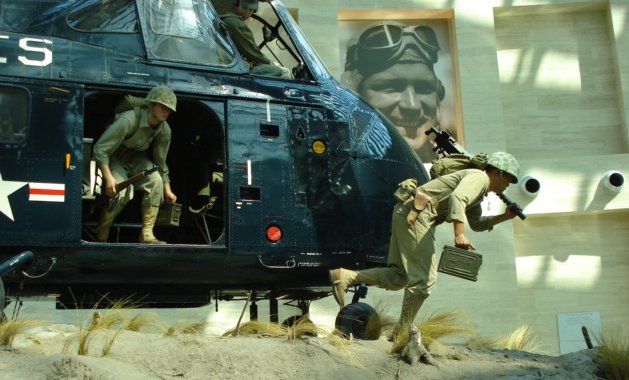
Above is the atrium from below.
After getting to know & admire the Marines in Iraq, I certainly had to take advantage of our new Marine Museum in the Washington area. It is at Quantico and they just finished it last year. Please click on the link for real details. I will supply only my personal impressions.
Below is the atrium from above.

Before I went to Iraq, I knew some individual Marines, mostly U.S. Embassy guards and military attaches, but I had not seen them in their own environment and I have to admit that most of what I thought came from the media, where You have the heroic “Sands of Iwo Jima” image mixed with less favorable left wing impressions . It has become a little hard for me to accurately recall how I felt before I went to live with Marines in Iraq. When I think back, I do remember that when they told me that it was a Marine COMBAT regiment and that they would issue me protective gear, I was a little apprehensive, both about being embedded with Marines and being issued protective gear. If they give you protective gear, it might be because it is dangerous enough to need it. I guess I was expecting to be in that “Sands of Iwo Jima” environment, or at least the one I saw on television news. Both were kind of scary. Fortunately, it was a lot more peaceful than that and the Marines were different too.
In the real life Marines, I found innovative problem solvers. They take pride in never really having enough resources and improvising to get the job done. But they are not merely men of action. Although some don’t like to admit it, many are true intellectuals. They are widely read and they try to adapt historical experience and theoretic knowledge to their practical problems. Their jobs give them a unique ability to test theory and the fact that lives are on the line makes them take this very seriously. There is an old saying that an intellectual is someone who will accept anything except responsibility. This is where Marines differ from the academic intellectuals who sometimes criticize them.
You can see that I have come to admire Marines, as does almost anybody who has real and sustained contact with them. They still have a practical belief in honor, virtue and honesty. Theirs is a tough life. I don’t think it is for everyone and the Marines certainly agree. I was fortunate to get to know Marines close up and I wanted to take the boys down there to share some of that too. Visiting the Museum is not much of an introduction, but it is something. Maybe the Marines could be an option for them.

The Museum has very clean architectural lines. It has a sweep like that of the Iwo Jima memorial. The exhibits are based on Marine history and actual Marines. Each of the characters in the dioramas in modeled on an actual Marine including facial features and body proportions. It is an interesting detail. BTW – we went with the free docent tour. I suggest everybody do that. Otherwise, you might not find out or pay attention to details like the one above.
I got a slightly different impression of WWII from being in Iraq and visiting the museum helped confirm that. In the last years of the war, the Japanese strategy was to try to kill as many Americans as possible. They knew they couldn’t win against the U.S., but they figured that if they killed enough Americans, they could achieve an negotiated peace. The Marines paid the biggest price, as the Japanese just fought to the death on each little piece of ultimately indefensible land. We did not give up, but we might have. People living in the past made decisions as we do today. They didn’t know they were living in the past and they did not know the outcomes, because those outcomes had yet to be decided. There is no such things as fate.
The docent talked about the famous picture of the flag raising on Mount Suribachi. People see that as the mark of victory. Actually many days of fighting followed the flag raising and three of the men in the picture were subsequently killed. There is good book and movie about what happened to the surviving men involved called “Flags of Our Fathers.”
In the36 days of fighting there were 25,851 US casualties; 6825 were killed. And Iwo Jima is a really small place, about the size of Al Asad and just about as featureless. Or put another way, it is only about 1/4 the size of Milwaukee (only the city, not the whole county). We have lots of heros in our current generation too, but fortunately we have not faced anything like that in Iraq. The “greatest generation” earned the title.
